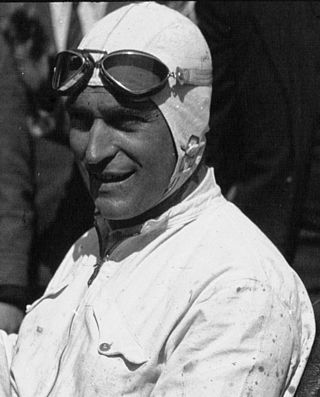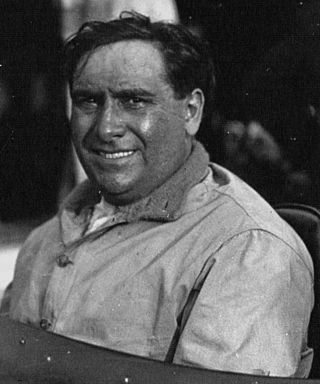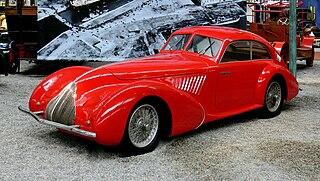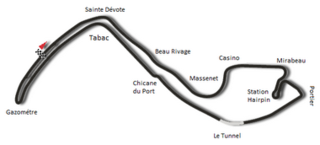
Tazio Giorgio Nuvolari was an Italian racing driver, considered by many as the best in history. He first raced motorcycles and then concentrated on sports cars and Grand Prix racing. Originally of Mantua, he was nicknamed il Mantovano Volante and Nuvola ("Cloud"). His victories—72 major races, 150 in all—included 24 Grands Prix, five Coppa Cianos, two Mille Miglias, two Targa Florios, two RAC Tourist Trophies, a Le Mans 24-hour race, and a European Championship in Grand Prix racing. Ferdinand Porsche called him "the greatest driver of the past, the present, and the future".

Achille Varzi was an Italian racing driver. He is remembered as the chief rival of Tazio Nuvolari, and was the winner of the 1933 Monaco Grand Prix.

Carrozzeria Touring Superleggera is an Italian automobile coachbuilder. Originally established in Milan in 1925, Carrozzeria Touring became well known for both the beauty of its designs and patented superleggera construction methods. The business folded in 1966. In 2006 its brands and trademarks were purchased and a new firm was established nearby to provide automotive design, engineering, coachbuilding, homologation services, non-automotive industrial design, and restoration of historic vehicles.

Luigi Cristiano Fagioli, nicknamed "the Abruzzi robber", was an Italian motor racing driver. Having won his last race at 53 years old, Fagioli holds the record for the oldest Formula One driver to win a race. He is also the only Formula One Grand Prix winner born in the 19th century, and the only Grand Prix racing driver to have won a championship race in both the AIACR European Championship and the World Drivers' Championship.

Giuseppe Campari was an Italian opera singer and Grand Prix motor racing driver.

Baconin Borzacchini was an Italian racing driver who often competed under the nom de courseMario Umberto Borzacchini.

The Alfa Romeo 8C was a range of Alfa Romeo road, race and sports cars of the 1930s.

The Alfa Romeo P3, P3 monoposto or Tipo B was a classic Grand Prix car designed by Vittorio Jano, one of the Alfa Romeo 8C models. The P3 is considered to be the world's first genuine single-seat Grand Prix racing car and was Alfa Romeo's second monoposto after the Tipo A monoposto (1931). It was based on the earlier successful Alfa Romeo P2. Taking lessons learned from that car, Jano went back to the drawing board to design a car that could last longer race distances.

The Maserati 8C was a Grand Prix race car built by Maserati between 1931 and 1933. The 8C was being designed by Alfieri Maserati in the early 1930s; however, he died before its completion.

The 1935 Grand Prix season was the second year of the new 750 kg Formula. The success of the previous year encouraged the AIACR to reinitiate the European Championship. It was composed of the seven national Grands Prix and was won by Rudolf Caracciola, driving for the Mercedes-Benz team. The team dominated the season winning five of those Grand Épreuves, as well as four of the other major races of the season. However, in one of the great motor-races in sporting history, Tazio Nuvolari in a Scuderia Ferrari Alfa Romeo beat the combined numbers of the German teams in their home Grand Prix. The season also saw the arrival on the international stage of the bright young talent Bernd Rosemeyer in the Auto Union team.

The 1931 Grand Prix season was a watershed year, with the advent of the AIACR European Championship. After several years of Grand Prix racing in the doldrums with little technical development, 1931 saw new models come from all three main manufacturers: Bugatti, Maserati and Alfa Romeo.

The 1932 Grand Prix season marked the second year of the AIACR European Championship. It saw the debut of Alfa Romeo's sensational new Tipo B and with it, Tazio Nuvolari won the Championship driving for the Alfa Corse works team. The 40-year old Nuvolari won two of the three rounds and was second in the other. Still running to a Formula Libre rules for the cars, the regulations were revised to set the races to be between five and ten hours. However, all three national committees ran their races to the minimum time-limit.

The 1933 Grand Prix season was an intermediate year, as it would be the last season for the current AIACR regulations before a new weight-formula was introduced in 1934. As such, the European Championship was not held and the manufacturers held back on further developments of their existing models. Alfa Romeo, following an Italian government financial bailout and like Mercedes-Benz the previous year, had shut down its Alfa Corse works team. Scuderia Ferrari, their regular customer team took up the role of racing Alfa Romeos and a number of ex-works drivers moved across to join their ranks. They were not allowed, however, to buy the impressive Tipo B that had been so dominant in the previous season.

The Alfa Romeo Tipo 308 or 8C-308 is a Grand Prix racing car made for the 3 litre class in 1938. Only four cars were produced, actually modified from Tipo C with the engine mounted lower into the chassis and a slimmer body. The chassis was derived from the Tipo C and the engine from the 8C 2900. The 308 was engineered by Gioacchino Colombo under the control of Enzo Ferrari who was then in charge of Alfa's racing team, Alfa Corse. The car debuted at the Pau Grand Prix in 1938, where two cars were entered to race, one for Tazio Nuvolari and the other for Luigi Villoresi. Both drivers had to withdraw from competition, however Nuvolari had by then set a lap record. The next race was the Tripoli Grand Prix. The new 312 and 316 were entered, but they had engine trouble during practice and Clemente Biondetti took the start at the wheel of the 308 held in reserve. He failed to finish, while Hermann Lang, driving a Mercedes-Benz W154, was the winner. In this race, Eugenio Siena, driving a 312, was killed after hitting a wall.
The 1934 Grand Prix season saw the advent of the new 750 kg Formula. In an effort to curb the danger of rising speeds, the AIACR imposed this upper weight limit that effectively outlawed the large capacity engines. The incumbent manufacturers Alfa Romeo, Maserati and Bugatti had been preparing their new models with varying success – the best of which was the Alfa Romeo Tipo B. However, it was the state-sponsored arrival of the two German teams, Mercedes-Benz and Auto Union, and their innovative and progressive cars that ignited a new, exciting era of motor racing.

Luigi Arcangeli was an Italian motorcycle and car racer.

The 1931 Monaco Grand Prix was a Grand Prix motor race held at the Circuit de Monaco on 19 April 1931.
The 1930 Grand Prix season continued the malaise that had taken over the sport. Although there was little technical advance more privateer teams were forming, getting some factory support. The AIACR continued to mandate its fuel-regulated Formula Libre rules. Across the Atlantic, the AAA abandoned the AIACR regulations. Their new regulations were derisively called the “Junk Formula” by purists, opening up to their own version of Formula Libre: with modified stock-standard cars of up to 366 cu in (6-litres) with two seats.

The Tunis Grand Prix or Grand Prix de Tunis was a motor race held in the 1920s and 30s in Tunis, the capital of the African colony of the French protectorate of Tunisia.

The 1930 Monza Grand Prix was a Grand Prix motor race held at the Autodromo Nazionale di Monza on 7 September 1930. There were four 14-lap heats, a 7-lap repêchage, and a 35-lap final, which was won by Achille Varzi in a Maserati. His teammates, Luigi Arcangeli and Ernesto Maserati, completed the podium.


















